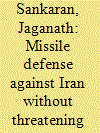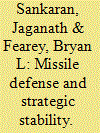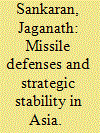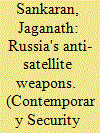|
|
|
Sort Order |
|
|
|
Items / Page
|
|
|
|
|
|
|
| Srl | Item |
| 1 |
ID:
183649


|
|
|
|
|
| Summary/Abstract |
North Korea has made significant strides in its attempt to acquire a strategic nuclear deterrent. In 2017, it tested intercontinental ballistic missiles (ICBMs) and completed a series of nuclear test explosions. These may provide North Korea with the technical foundation to deploy a nuclear-armed ICBM capable of striking the United States. The Ground-based Midcourse Defense (GMD) missile defense system is intended to deter North Korean nuclear coercion and, if deterrence fails, to defeat a limited North Korean attack. Despite two decades of dedicated and costly efforts, however, the GMD system remains unproven and unreliable. It has not demonstrated an ability to defeat the relatively simple and inexpensive countermeasures that North Korea can field. The GMD system has suffered persistent delays, substantial cost increases, and repeated program failures because of the politically motivated rush to deploy in the 1990s. But GMD and other U.S. missile defense efforts have provoked serious concerns in Russia and China, who fear it may threaten their nuclear deterrents. Diplomacy and deterrence may reassure Russia and China while constraining North Korea's nuclear program. An alternate airborne boost-phase intercept system may offer meaningful defense against North Korean missiles without threatening the Russian or Chinese deterrents.
|
|
|
|
|
|
|
|
|
|
|
|
|
|
|
|
| 2 |
ID:
135168


|
|
|
|
|
| Summary/Abstract |
In April 2011, Pakistan declared that it had tested a short-range battlefield nuclear missile, the Nasr.1 Since then, prominent purveyors of Pakistani nuclear doctrine, including Lieutenant General Khalid Kidwai and former diplomat Maleeha Lodhi, have portrayed the Nasr missile as a counter to India’s “Cold Start” war doctrine.2
That doctrine supposedly aims at rapid but limited retaliatory incursions into Pakistan by the Indian army to seize and hold narrow slices of territory in response to a terrorism event in India involving Pakistanis. The rationale is that the seized territory would be returned in exchange for Pakistani extradition of extremists inflicting terrorism onto India. The doctrine is based on the assumption that Pakistan would not resort to the use of nuclear weapons in response to a limited Indian incursion, thereby offering space for conventional conflict even in a nuclearized environment.
Pointing to this Indian war doctrine, Pakistani decision-makers now argue that the deterrent value of their current arsenal operates only at the strategic level. According to this line of reasoning, the gap at the tactical level gives India the freedom to successfully engage in limited Cold Start-style military operations without fear of nuclear escalation. Development of the low-yield, tactical battlefield nuclear weapon, the Nasr missile, is seen as the solution providing “flexible deterrence options”3 for an appropriate response to Cold Start, rather than massive nuclear retaliation against India. Nasr proponents argue that by maintaining “a credible linkage between limited conventional war and nuclear escalation,” the missile will deter India from carrying out its plan.4
This approach might appear to be sensible, but it suffers from two important flaws. First, the Cold Start doctrine has not been actively implemented and therefore does not seem to represent a genuine threat to Pakistan. Second, battlefield nuclear weapons are a key part of the proposed solution, but it may be extremely difficult to establish a command and control system that would effectively preclude the possibility of an accidental or unauthorized launch.
|
|
|
|
|
|
|
|
|
|
|
|
|
|
|
|
| 3 |
ID:
128058


|
|
|
|
|
| Publication |
2013.
|
| Summary/Abstract |
All recent U.S. efforts after the conclusion of the 2010 New Strategic Arms Reduction Treaty (New START) to move ahead on bilateral nuclear arms reductions with Russia have stalled over Russian concerns regarding the capabilities of the European Phased Adaptive Approach, as the Obama administration's missile defense policy in Europe is formally known, and its effect on Russian nuclear retaliatory potential.Since the early stages of the phased adaptive approach, Russian officials have cited it as an obstacle to further nuclear arms reduction. Last March, however, U.S. Secretary of Defense Chuck Hagel announced a restructuring of the approach, canceling the planned implementation of its fourth phase, which had prompted the strongest Russian complaints.[1] The key feature of that phase was the deployment of the Standard Missile-3 (SM-3) IIB interceptors in Poland. The SM-3 IIB, with a planned velocity of 5.5 kilometers per second, would have had the ability to fly further and faster than any other missile in the system
|
|
|
|
|
|
|
|
|
|
|
|
|
|
|
|
| 4 |
ID:
156084


|
|
|
|
|
| Summary/Abstract |
South Korea is threatened by its troubled relationship with North Korea. North Korea possesses a large cache of missiles as well as chemical and biological weapons, and the future potential to mount nuclear weapons on its missiles. The United States is also challenged because of its defense commitments to Seoul. As a countermeasure, the United States and South Korea decided to deploy Terminal High Altitude Area Defense (THAAD) missile defenses in South Korea. However, China has objected. Chinese scholars believe the THAAD radar would be able to track Chinese inter-continental ballistic missiles, thereby weakening their deterrent. A technical analysis does not support this assertion. However, it is vital for South Korea, given its proximity and economic interdependence, to reassure China. South Korea should highlight that THAAD will be deployed by the United States Forces Korea and is not a commitment by Seoul to become part of U.S.-led missile defenses in the Asia-Pacific.
|
|
|
|
|
|
|
|
|
|
|
|
|
|
|
|
| 5 |
ID:
177622


|
|
|
|
|
| Summary/Abstract |
The contention over the quantity and quality of regional missile defenses forward-deployed by the United States in the Asia-Pacific region animates much of the US–China disagreement about strategic stability. The Chinese argue that the deployed assets exceed reasonable defensive requirements and suggest that if these missile-defense deployments continue, they will be forced to increase the size of their nuclear arsenal. In disagreement, the United States claims that regional missile defenses are defensive by design, limited in scope, and necessary to defeat a North Korean missile campaign. In this article, a series of simulation experiments were developed to empirically test these opposing arguments over missile defenses and strategic stability. The simulations indicate that current deployments are necessary for defense and proportional to the threat. The analysis also argues that current deployments do not possess the ability to alter the US–China strategic nuclear balance significantly. The article concludes with a discussion of other subjective aspects of national security that may explain Chinese concerns and explore possible ways to reassure China.
|
|
|
|
|
|
|
|
|
|
|
|
|
|
|
|
| 6 |
ID:
179301


|
|
|
|
|
| Summary/Abstract |
China has amassed a large arsenal of regional ballistic missiles capable of ranging all of Asia-Pacific. The Chinese People’s Liberation Army Rocket Force (PLARF) has also developed detailed doctrines articulating the use of these missiles to deny the United States and allied nations’ freedom of action during a regional contingency. The PLARF practices many of its exercises based on these doctrines and under realistic conditions that mimic adversary counter-tactics. In response, the U.S. and allied states deploy significant ballistic missile defense assets to deter and defend against the use of missiles. In this paper, an empirical evaluation of the performance of these regional missile defenses is conducted. The results indicate that regional missile defense remain robust and effective against small coercive signaling strikes. Against a limited suppression strike campaign aiming to delay and disrupt military movements, missile defenses remain robust if an early warning is available. Finally, against a large-scale coordinated missile campaign, missile defense assets are spread thin, and marginal cost to the defense is substantially high. If China can launch multiples waves of large-scale missile salvos or if critical missile assets are rendered nonfunctional, it could cause severe damage to military capabilities.
|
|
|
|
|
|
|
|
|
|
|
|
|
|
|
|
| 7 |
ID:
136642


|
|
|
|
|
| Summary/Abstract |
Pakistan has introduced a new battlefield nuclear weapon, Nasr, into its arsenal. Nasr, a short-range ballistic missile, was first flight-tested in 2011. Pakistani leaders have declared that the weapon is meant to deter India from executing its Cold Start war doctrine. The doctrine was conceived by members of India's army and its strategic community in 2004 as a solution to perceived operational shortcomings of the army in responding to major terrorist incidents involving Pakistanis. It recommends the positioning of smaller army units at the international border with the capability to rapidly invade Pakistan and occupy narrow slices of territory, while denying Pakistan the ability to anticipate the attack and to immediately assemble a counterattack force. The Cold Start war doctrine, however, has since been publicly disavowed by the Indian government, and the Indian army has not reorganized or equipped its troops in a manner consistent with the doctrine. Further, the use of battlefield nuclear weapons inside Pakistan or near the densely populated border regions could potentially cause civilian casualties in the tens of thousands. These factors should dissuade Pakistan from deploying the Nasr missile.
|
|
|
|
|
|
|
|
|
|
|
|
|
|
|
|
| 8 |
ID:
162102


|
|
|
| 9 |
ID:
174620


|
|
|
|
|
| Summary/Abstract |
In 2016 and 2017, North Korea demonstrated a range of technologies that brought it much closer to deploying an intercontinental ballistic missile (ICBM). After the November 2017 test of the Hwasong-15 missile, Kim Jong Un declared that North Korea has “finally realized the great historic cause of completing the state nuclear force” and is now immune to American nuclear blackmail and coercion.
|
|
|
|
|
|
|
|
|
|
|
|
|
|
|
|
| 10 |
ID:
184606


|
|
|
|
|
| Summary/Abstract |
Russia conducted a direct-ascent hit-to-kill anti-satellite (ASAT) test on November 15, 2021, striking a Russian satellite and rendering it into more than 1,500 pieces of orbital debris.1 Reacting to the test, U.S. Space Command commander Army Gen. James Dickinson claimed that Russia is “deploying capabilities to actively deny access to and use of space by the United States and its allies.”2 He further noted that Russia’s counterspace weapons systems undermine strategic stability.
|
|
|
|
|
|
|
|
|
|
|
|
|
|
|
|
| 11 |
ID:
186555


|
|
|
|
|
| Summary/Abstract |
Russia has recently tested several anti-satellite weapons. The Russian military literature reveals hedging and offsetting strategies behind these actions. First, Russians cast their weapons as a mirror response to American experiments. Russians fear a technological surprise and suggest that their experimentation hedges against significant advantages that may accrue to the United States from dominating space. Second, Russians perceive satellites providing vital targeting and navigation information as crucial enablers of U.S. and NATO aerospace precision strike weapons. Therefore, dependence on space-based assets is a vulnerability that Russia cannot fail to take advantage of in a crisis to offset U.S. and NATO military superiority. Some unilateral measures such as deploying cheaper and distributed small satellite constellations can reduce U.S. and allied vulnerabilities. Bilateral behavioral norms can offer reassurances to both the United States and Russia. However, deeper regulation and limits on emerging strategic aerospace weaponry may also be required.
|
|
|
|
|
|
|
|
|
|
|
|
|
|
|
|
|
|
|
|
|